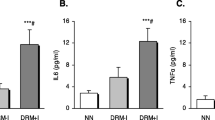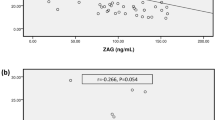Abstract
Purpose
Low-grade chronic inflammation is present in patients on peritoneal dialysis (PD) and in metabolic syndrome (MS). Due to possible greater endothelial changes in dialyzed patients, inflammatory response and oxidative stress are probably stronger in patients on PD. The objective of the study was to investigate possible in between adipokines, inflammatory, endothelial and oxidative stress markers between MS patients and patients on PD.
Methods
Concentrations of adipokines (leptin, resistin), inflammatory markers [interleukin-6 (IL-6), soluble tumor necrosis factor alpha receptor (sTNF-R), myeloperoxidase (MPO), monocyte chemoattractant protein 1 (MCP-1)] and endothelial markers [soluble intracellular adhesion molecule-1 (sICAM-1), soluble CD40 ligand (sCD40L)] were determined in 55 MS patients and 18 patients on PD, with flow cytometry, and visfatin concentration was measured with ELISA. Routine biochemistry parameters were measured on Beckman Coulter AU2700 analyzer.
Results
Patients on PD have significantly higher concentration of: CRP [6.5 (3.7–12.1) versus 2.6 (1.3–4.0) mg/L, P < 0.001], IL-6 [13.83 (8.48–31.31) versus 2.05 (0.67–4.11) pg/mL, P < 0.001], MCP-1 [2172.28 (1563.84–2922.77) versus 1353.58 (1166.33–1961.70) pg/mL, P = 0.023], sTNF-R [18.25 (12.81–25.22) versus 1.23 (0.89–1.43) ng/mL, P < 0.001] and sICAM-1 [830.03 (599.21–967.02) versus 463.85 (315.25–751.71) ng/mL, P = 0.006] than subjects with MS. MS patients have higher concentrations of MPO [175.47 (120.15–231.67) versus 101.76 (53.55–186.06) ng/mL, P = 0.016] and visfatin [1.5 (0.9–2.3) versus 0.9 (0.6–1.6) ng/mL, P = 0.013].
Conclusion
In patients on PD, inflammatory reaction is higher than in patients with MS. On the contrary, patients with MS have stronger oxidative stress response and adipose tissue activity caused probably by the chronic low level of inflammation and underlying metabolic disorders.
Similar content being viewed by others
References
Biljak VR, Honovic L, Matica J, Knezevic B, Vojak SS (2015) Laboratory diagnostics of chronic kidney disease in Croatia: state of the art: on behalf of the joint working group of Croatian society of medical biochemistry and laboratory medicine and Croatian chamber for medical biochemists for laboratory diagnostics in chronic kidney disease. Biochem Med (Zagreb) 25:73–83
KDIGO 2012 (2013) Clinical practice guideline for the evaluation and management of chronic kidney disease. Kidney Int Suppl 3:1–150
Liu KD, Chertow GM (2010) Dialysis in the treatment of renal failure. In: Jameson LJ, Loscalzo J (eds) HARRISON’S nephrology and acid–base disorders, 2nd edn. McGraw-Hill, New York, pp 130–136
Wang AY (2005) Prognostic value of C-reactive protein for heart disease in dialysis patients. Curr Opin Investig Drugs 6:879–886
Velloso MS, Otoni A, de Paula Sabino A, de Castro WV, Pinto SW, Marinho MA, Rios DR (2014) Peritoneal dialysis and inflammation. Clin Chim Acta 430:109–114
Carrero JJ, Stenvinkel P (2009) Persistent inflammation as a catalyst for other risk factors in chronic kidney disease: a hypothesis proposal. Clin J Am Soc Nephrol 4(Suppl 1):S49–S55
Grundy SM, Brewer HB, Cleeman JI, Smith SC, Lenfant C (2004) Definition of metabolic syndrome: report of the National Heart, Lung, and Blood Institute/American Heart Association conference on scientific issues related to definition. Circulation 109(3):433–438
Kaur J (2014) A comprehensive review on metabolic syndrome. Cardiol Res Pract 2012:943162
Faloia E, Michetti G, De Robertis M, Luconi MP, Furlani G, Boscaro M (2012) Inflammation as a link between obesity and metabolic syndrome. J Nutr Metab 2012:476380
Hopps E, Noto D, Caimi G, Averna MR (2010) A novel component of the metabolic syndrome: the oxidative stress. Nutr Metab Cardiovasc Dis 20(1):72–77
Nishimura S, Manabe I, Nagai R (2009) Adipose tissue inflammation in obesity and metabolic syndrome. Discov Med 8(41):55–60
El-Shahhat N, Ramadan MM, El-Malkey N, Omar AA, El-Aal IAA, Eneen A (2011) Soluble CD40 ligand, interleukin (IL)-6, and hemostatic parameters in metabolic syndrome patients with and without overt ischemic heart disease. Egypt Heart J 63(3):131–135
Loughrey BV, McGinty A, Young IS, McCance DR, Powell LA (2013) Increased circulating CC chemokine levels in the metabolic syndrome are reduced by low-dose atorvastatin treatment: evidence from a randomized controlled trial. Clin Endocrinol 79:800–806
Consultation, WHO Expert (2008) Waist circumference and waist-hip ratio. Report of a WHO expert consultation, pp 8–11
Hosseinzadeh-Attar MJ, Golpaie A, Foroughi M, Hosseinpanah F, Zahediasl S, Azizi F (2016) The relationship between visfatin and serum concentrations of C-reactive protein, interleukin 6 in patients with metabolic syndrome. J Endocrinol Invest 39(8):917–922
Yegin ZA, İyidir ÖT, Demirtaş C, Suyanı E, Yetkin I, Paşaoğlu H, İlhan Ç, Sucak GT (2015) The interplay among iron metabolism, endothelium and inflammatory cascade in dysmetabolic disorders. J Endocrinol Invest 38(3):333–338
Mehrotra R, de Boer IH, Himmelfarb J (2013) Adverse effects of systemic glucose absorption with peritoneal dialysis: how good is the evidence? Curr Opin Nephrol Hypertens 22:663–668
Fonseca LJSD, Nunes-Souza V, da Silva Guedes G, Schettino-Silva G, Mota-Gomes MA, Rabelo LA (2014) Oxidative status imbalance in patients with metabolic syndrome: role of the myeloperoxidase/hydrogen peroxide axis. Oxid Med Cell Longev 2014:898501
Tung C-W, Hsu Y-C, Shih Y-H, Lin C-L (2015) Association of adiponectin with high sensitivity c-reactive protein and clinical outcomes in peritoneal dialysis patients: a 3.5-year follow-up study. PLoS One 10(10):e0141058
Sikorska D, Pawlaczyk K, Roszak M, Czepulis N, Oko A, Karczewski M, Breborowicz A, Witowski J (2016) Preliminary observations on the association between serum IL-6 and hydration status and cardiovascular risk in patients treated with peritoneal dialysis. Cytokine 85:171–176
Neirynck N, Glorieux G, Schepers E, Verbeke F, Vanholder R (2015) Soluble tumor necrosis factor receptor 1 and 2 predict outcomes in advanced chronic kidney disease: a prospective cohort study. PLoS One 10(3):e0122073
Wu CL, Wu HM, Chiu PF, Liou HH, Chang CB, Tarng DC, Chang CC (2014) Associations between the duration of dialysis, endotoxemia, monocyte chemoattractant protein-1, and the effects of a short-dwell exchange in patients requiring continuous ambulatory peritoneal dialysis. PLoS One 9(10):e109558
Halcox JPJ, Ozkor MA, Mekonnen G, Quyyumi AA (2014) Coronary endothelial dysfunction, obesity and metabolic syndrome. J Diabetes Metab 5:362. doi:10.4172/2155-6156.1000362
Tucker P, Scanlan A, Dalbo VJ (2015) Chronic kidney disease influences multiple systems: describing the relationship between oxidative stress, inflammation, kidney damage, and concomitant disease. Oxid Med Cell Longev 806358:1–8
Zhao LQ, Wei RL, Cheng JW, Cai JP, Li Y (2010) The expression of intercellular adhesion molecule-1 induced by CD40-CD40L ligand signaling in orbital fibroblasts in patients with Graves’ ophthalmopathy. Invest Ophthalmol Vis Sci 51(9):4652–4660
Park SH, Do JY, Kim YH, Lee HY, Kim BS, Shin SK et al (2012) Effects of neutral pH and low-glucose degradation product-containing peritoneal dialysis fluid on systemic markers of inflammation and endothelial dysfunction: a randomized controlled 1-year follow-up study. Nephrol Dial Transplant 27(3):1191–1199
Celap I, Simundic AM, Nikolac N, Miler M, Zec I, Altabas K, Sefer S (2013) Visfatin is not associated with inflammatory markers in patients on hemodialysis. Clin Lab 59(11–12):1253–1259
Olszanecka-Glinianowicz M, Kocełak P, Janowska J, Skorupa A, Nylec M, Zahorska-Markiewicz B (2011) Plasma visfatin and tumor necrosis factor-alpha (TNF-α) levels in metabolic syndrome. Kardiol Pol 69(8):802–807
Acknowledgments
This study was supported by Ministry of Science, Education and Sports, Republic of Croatia, project Number: 134-1340227-0200.
Author information
Authors and Affiliations
Corresponding author
Ethics declarations
Conflict of interest
None declared.
Ethical approval
The study was approved by the Sestre milosrdnice Medical School University Hospital Ethical Committee. The study was performed in accordance with the principles of Good clinical practice of the International Conference on Harmonization (ICH GCP) and the Declaration of Helsinki.
Informed consent
All participants have signed the informed consent.
Rights and permissions
About this article
Cite this article
Miler, M., Nikolac, N., Segulja, D. et al. Is peritoneal dialysis causing a measurable burden of inflammatory and endothelial injury on top of metabolic syndrome?. J Endocrinol Invest 40, 163–168 (2017). https://doi.org/10.1007/s40618-016-0540-7
Received:
Accepted:
Published:
Issue Date:
DOI: https://doi.org/10.1007/s40618-016-0540-7




